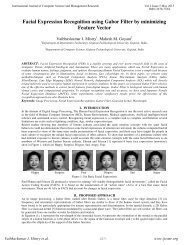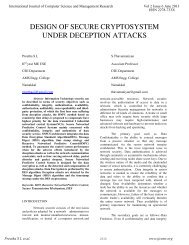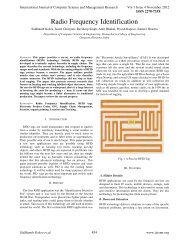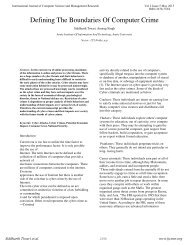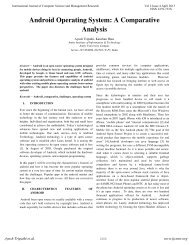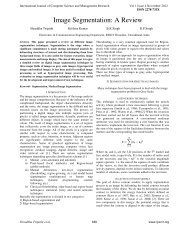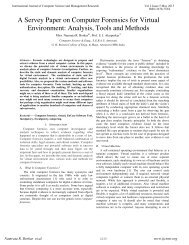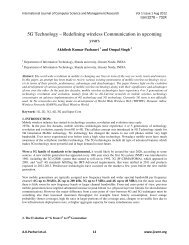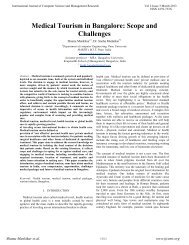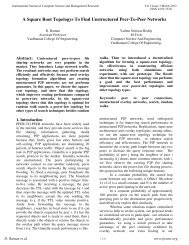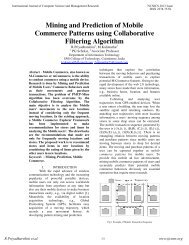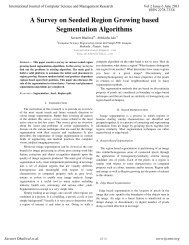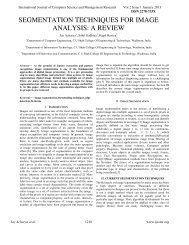Trust Based Resource Allocation Technique for Anonymous ... - ijcsmr
Trust Based Resource Allocation Technique for Anonymous ... - ijcsmr
Trust Based Resource Allocation Technique for Anonymous ... - ijcsmr
You also want an ePaper? Increase the reach of your titles
YUMPU automatically turns print PDFs into web optimized ePapers that Google loves.
International Journal of Computer Science and Management Research Vol 2 Issue 2 February 2013<br />
ISSN 2278-733X<br />
This process continues till packet reaches the destination.<br />
Step 4<br />
When the destination node receives the packet, it copies<br />
the value of the BW BN to the new packet and sent back to<br />
the source node using the reverse path.<br />
Step 5<br />
The intermediate node upon receiving the data packet<br />
updates its routing table with the new BW BN and then<br />
<strong>for</strong>warded the packet to the next node.<br />
Step 6<br />
When the data packet reaches the source node, the source<br />
establishes the real-time flow based on the value of the<br />
BW BN field. If the value of B av in source node is greater<br />
than or equal to the BW BN value in the packet. Then<br />
reservation of bandwidth <strong>for</strong> the flow can proceed<br />
Else<br />
The BW BN value in the new data packet is overwritten<br />
with the (smaller) value B av .<br />
end if<br />
Rate monitoring<br />
In the rate monitoring strategy <strong>for</strong> a real time<br />
flow, the rate of flow is measured and compared with the<br />
assigned rate which is updated in the routing table. If the<br />
rate measured is lesser than the reserved rate by the<br />
sufficient margins, then the reserved rate is reduced by<br />
certain factor.<br />
3.3. ASOR: An <strong>Anonymous</strong> routing scheme<br />
The anonymous routing scheme comprises of<br />
two phases: anonymous key establishment as the first<br />
phase and the route discovery process as the second<br />
phase. In the first phase of the scheme, trusted node<br />
employs anonymous key establishment to anonymously<br />
construct a set of session keys with each of its trusted<br />
neighbors. Then under protection of these session keys,<br />
the route discovery process can be initiated by the source<br />
node to discover a route to the destination node.<br />
1. <strong>Anonymous</strong> key establishment<br />
(1) Group signature is computed using its private signing<br />
key, other nodes can verify this signature using the group<br />
public key. Then it broadcasted within its<br />
trusted<br />
neighborhood.<br />
(2) A trusted neighbor X of S receives the message from<br />
S and verifies the signature in that message. If the<br />
verification is successful, X chooses a random number<br />
and computes a signature using its own private key.<br />
(3) Upon receiving the reply from X, , S verifies if it is<br />
valid, S proceeds to compute the session key between X<br />
and itself. S also generates a local broadcast key K S ∗, to<br />
its neighbor X to in<strong>for</strong>m X about the established local<br />
broadcast key. Then X receives the message from S and<br />
computes the same session key. It then decrypts the<br />
message to get the local broadcast key K S ∗.<br />
1. S *: <strong>Trust</strong>_Req, BW BN, r s P, SIGg skS<br />
(r S P)<br />
2. XS: r x P, SIGg skx (r x P), E ksx (K s* )<br />
3. SX:E ksx (K s*<br />
Figure 2. <strong>Anonymous</strong> Key establishment<br />
Figure 2 illustrates the anonymous key establishment<br />
process.<br />
And below table shows notations used in<br />
proposed system.<br />
Table I<br />
Notations<br />
HTLCK<br />
High trust Level Community Key<br />
MTLCK<br />
High trust Level Community Key<br />
TYPE Message Type<br />
TRUST_REQ <strong>Trust</strong> Requirement<br />
TPK<br />
Temporary Public Key<br />
BW BN<br />
Bottleneck Bandwidth<br />
Av<br />
Available Bandwidth<br />
A<br />
A node in Ad hoc N\W, and its identity<br />
S<br />
Secret key owned by server<br />
H i (*) Secure Hash function, I = 1, 2<br />
gsk A<br />
Node A’s private group signature key<br />
gpk<br />
The public group signature key<br />
K A<br />
Node A’s private ID based key<br />
E A (*)<br />
ID based encryption using A’s public<br />
key<br />
K A*<br />
A local broadcast key<br />
K AX<br />
Session key shared b/w A and X<br />
Nym A<br />
Pseudonym only valid within A’s<br />
neighborhood<br />
Nym AX<br />
Pseudonym shared between A and X<br />
2. Route Request (RREQ):<br />
S chooses a random number, and uses the<br />
identity of node D to encrypt a trapdoor in<strong>for</strong>mation that<br />
only can be opened with D’s private IDbased key, S then<br />
selects a sequence number <strong>for</strong> this request, and another<br />
random number as the route pseudonym, which is used as<br />
the index to a specific route entry. To achieve<br />
unobservability, S chooses a nonce and calculates a<br />
pseudonym . After that, S encrypts these items using its<br />
local broadcast key K S∗. . Finally, S broadcast the below<br />
request:<br />
Nonce S , Nym S , E kS∗ (RREQ, N S , E D (S, D, r S P), seqno) (3)<br />
s*)<br />
Raghu. R et.al.<br />
1537<br />
www.<strong>ijcsmr</strong>.org




